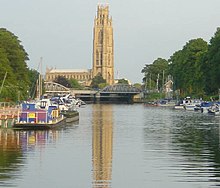St Botolph (Boston)
St Botolph in Boston (Lincolnshire) (formally St Botolph's Church of the Parish of Boston) is also known as Boston Stump known Anglican parish church of the East Anglian town. It is characterized by its 83 m (272 ft) high church tower closed with an octagon . The church, with its tower that can be seen from afar, is also called "the Lighthouse of the Fens ". The church is part of the Greater Churches Group.
history
The construction of the existing decorated style church named after St. Botolph began in 1309 under Sir John Truesdale; the choir and nave were completed around 1390. The tower, construction of which began around 1450, was not completed until the beginning of the 16th century in the perpendicular style . In 1612 the church was damaged by militant Puritans . It also suffered damage in the English Civil War in 1643. The choir vault was rebuilt in the 18th century and the east window was added in the 19th century. A major restoration took place from 1851 to 1853.
investment
The nave is 74 m long and 32 m wide. It is completed by the choir with the high altar in the east. The wooden nave vault from the 18th century was removed in the 20th century.
The lantern of the tower vault is provided with pinnacles .
Furnishing
The church has 62 misericords from 1390. The pulpit of the nonconformist vicar John Cotton is preserved in the nave.
The library above the portal has 150 prints from before 1600. Various pieces of equipment were added in the 19th century, including a baptismal font by Augustus Welby Northmore Pugin .
26 bells hang in the tower. 10 bells are used to ring the bell ; 15 are carillon bells.
The organ was built by the organ builder Harrison and Harrison. The instrument has 41 stops on three manual works and a pedal. The actions are electro-pneumatic.
|
|
|
|
|||||||||||||||||||||||||||||||||||||||||||||||||||||||||||||||||||||||||||||||||||||||||||||||||||||||||||||||||||||||||||||||||||||||||||||
literature
- Simon Jenkins: England's Thousand Best Churches . 1999: Allan Lane - The Penguin Press. ISBN 0-713-99281-6 . P. 367 ff.
Web links
Individual evidence
Coordinates: 52 ° 58 '43 " N , 0 ° 1' 33" W.



